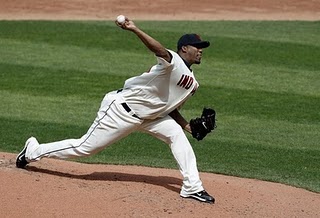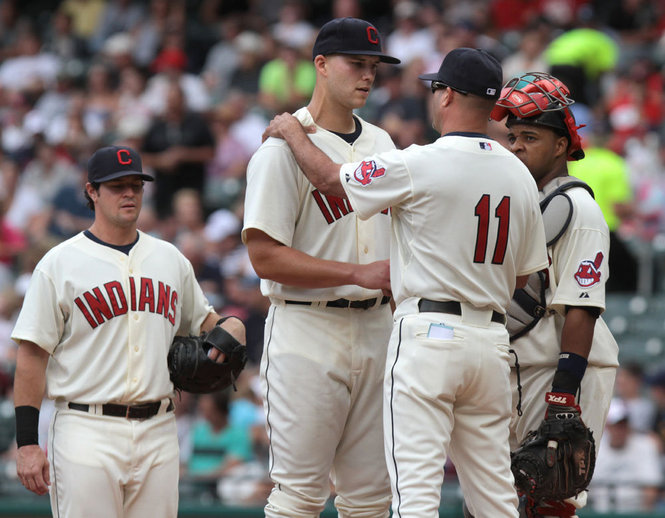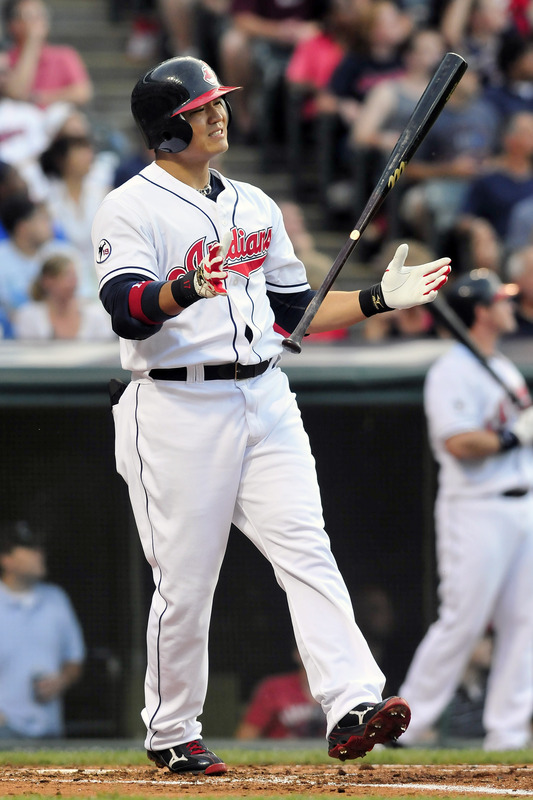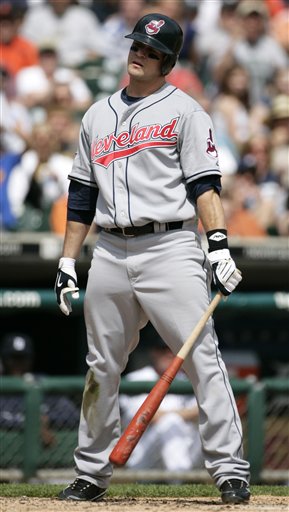 Indians Archive
Indians Archive  View from the Porch: Challenging Times Edition
View from the Porch: Challenging Times Edition
 While shooting nine holes on Friday afternoon with a buddy of mine, I had just finished topping my seventh or eighth ball in the first five holes when we began talking about how difficult golf is. It is a game that has to be played quite often to have any success. The motions of a golf swing need to be repetitive in order for the ball to have the proper trajectory. The club face is small and square and any fraction of an inch off the middle of the club face can drastically alter a shot.
While shooting nine holes on Friday afternoon with a buddy of mine, I had just finished topping my seventh or eighth ball in the first five holes when we began talking about how difficult golf is. It is a game that has to be played quite often to have any success. The motions of a golf swing need to be repetitive in order for the ball to have the proper trajectory. The club face is small and square and any fraction of an inch off the middle of the club face can drastically alter a shot.
Attempting to console me and my obvious frustration, Femur, whose real name is Mike, told me that he considers golf to be "The Ultimate Challenge". Up to that point, I had spent some time this week trying to determine what this week's View from the Porch topic would be. Hitting my one good shot per hole to drop a chip shot within six feet, I decided to roll with the Femur-inspired theme.
Every sport has an ultimate challenge. In hockey, it is being able to make the proper pass with a 200 pound man speeding toward you in excess of 25 miles per hour about to run you over. With golf, on a given hole, it can change. It can be hitting a narrow fairway with a tee shot. It can be reading the break on a downhill putt so you don't roll it off the green. With football, it depends on the player's position. It could be hitting a 52-yard field goal with a swirling wind or coming over the middle to catch a pass with the free safety waiting to nearly decapitate you. Think you could handle a car mere inches off the ground flying around at 220 mph?
That brings me to baseball. The game of baseball is full of nothing but challenges. To me, what separates baseball from the other sports is the nature of the challenges. It is a game that can go Rocky Marciano on your mind. There may not really be the threat of physical harm from an opponent, but a fastball traveling 97 mph on the inside part of the plate can be a shot across the bow.

Each at bat is a different challenge. Pitchers have several ways to attack a hitter and hitters face different arm angles, different types of breaks on pitches, and then have to get the ball to land somewhere through or over a series of well-placed defenders. All of this while trying to hit a ball that is less than three inches in diameter with a bat that has a barrel diameter of just less than three inches.
Some fans probably want to know why the Indians are struggling so much. Quite frankly, the players on the team are not equipped to overcome the challenges that baseball presents. Sure, sometimes a guy will barrel up a ball like Jack Hannahan did to tie Wednesday's game, but, overall, the majority of the roster is not skilled enough.
Notice that in all sports, the best players are the ones who rarely, if ever, slump. Consistent production is a challenge. The Indians, at any given time over the last month, have had to trot out a collection of players who have not had prolonged success in the Major Leagues, whether because they are not very good or because they do not have a long enough track record to qualify.
Here are my top three challenges for pitchers and hitters and I will examine why the current Indians roster has so much trouble with these challenges.
Pitchers
1. Throwing quality strikes: Throwing strikes is relatively easy. Considering that most of these guys would not have gotten as far as they have in their chosen careers by throwing balls all of the time, the act of throwing the ball over the play should come without much resistance. What is hard to do, however, is throw quality strikes. Quality strikes, to me, would be defined as pitches that are over the horizontal and vertical edges of the strike zone.
This also entails experimenting with the umpire's strike zone. As we have seen this year, the zone varies from umpire to umpire. To be honest, I have seen little consistency from umpires behind the dish this season. Using the early innings to test your limits is a skill that very few pitchers seem to have. Guys like Greg Maddux, Orel Hershisher, and Tom Glavine were brilliant in that respect. That is a challenge, and one that few hurlers can complete. But, as a starting pitcher, you have to try. You can establish the strike zone for your hitters because they are watching every pitch from the field (or the dugout in the DH's case). You can also see how far off the plate or how low below the knees you can throw to get a hitter out. The best way to record a strikeout is on your pitch. Rarely do hitters swing through bad pitches for K's.
consistency from umpires behind the dish this season. Using the early innings to test your limits is a skill that very few pitchers seem to have. Guys like Greg Maddux, Orel Hershisher, and Tom Glavine were brilliant in that respect. That is a challenge, and one that few hurlers can complete. But, as a starting pitcher, you have to try. You can establish the strike zone for your hitters because they are watching every pitch from the field (or the dugout in the DH's case). You can also see how far off the plate or how low below the knees you can throw to get a hitter out. The best way to record a strikeout is on your pitch. Rarely do hitters swing through bad pitches for K's.
2. Changing speeds: One of the chief attributes that separates good pitchers from grocery baggers is changing speeds effectively. Throwing a token change-up surrounded by fastballs does not work at the Major League level. Hitters at the major league level are there for a reason. They are good enough to select pitches to hit. Unless he is fooling or simply guessed wrong, many guys will not attempt to hit the offspeed stuff unless they have to. More on that in the hitters section.
From the pitcher's perspective, there are two goals that must be achieved in order to get hitters out. Keep them off balance and keep them from meeting the ball with the barrel of the bat. Good offspeed pitches do both. Offspeed pitches tend to have late break. This gets the hitter out on his front foot, throwing his balance and weight transfer out of whack, forcing him to lunge at the ball. When a hitter cannot properly transfer his weight, the bat comes through the zone early or late. If the bat head is not timed to the pitch's arrival, more often than not, the ball will not hit the barrel. This induces lazy ground balls and pop ups. There will be the occasional blooper base hit, but you can live with singles rather than doubles up the alley or homers 15 rows deep.
 3. Understanding that YOU have the advantage: Save for maybe bases loaded situations, the pitcher has the advantage over the batter in every plate appearance. The pitcher simply throws the pitch that is called. If he executes perfectly, there is very little chance of the hitter doing damage. This is why good hitters fail 70% of the time and most hitters fail 75% of the time. The onus is on the hitter to determine the break of the pitch, gauge the speed of the pitch, and then make contact with the pitch all in a matter of milliseconds.
3. Understanding that YOU have the advantage: Save for maybe bases loaded situations, the pitcher has the advantage over the batter in every plate appearance. The pitcher simply throws the pitch that is called. If he executes perfectly, there is very little chance of the hitter doing damage. This is why good hitters fail 70% of the time and most hitters fail 75% of the time. The onus is on the hitter to determine the break of the pitch, gauge the speed of the pitch, and then make contact with the pitch all in a matter of milliseconds.
Pitchers also have the advantage when it comes to making adjustments. Hitters can watch video, read scouting reports, and feed off what they see from other at bats, but there is no way to truly ascertain a pitcher's stuff until you see it from the batter's box. Pitchers, on the other hand, already know their stuff. They have also done their homework and seen where a hitter's holes are and have determined a plan of attack. If a pitcher attacked a hitter with fastballs in his first at bat and he hit a solid single to CF, he'll make an adjustment and throw more breaking balls in the next at bat. The hitter might see a fastball, but it might be off the plate or high. The pitcher may slow down his curve ball to give it more break or throw a slider harder to bounce it.
A pitcher who is able to use his advantage to his advantage is the kind of pitcher I want on my team.
Quite simply, the Indians pitchers, as a whole, have not been consistent enough with achieving these challenges. If you have been observant lately, you'd notice that hitters have been swinging early in counts and having success hitting fastballs. The Indians pitchers are not throwing enough quality strikes and not mixing in enough first pitch breaking balls.
Manny Acta and Tim Belcher have spent a lot of time stressing first pitch strikes. Indians pitchers appear apprehensive toward throwing first pitch breaking balls. First pitch breaking balls, even if out of the zone, can be effective because they keep the hitter off-stride and plant the seed in his head that breaking balls could come in any count.
Overall, what happens when teams go through bad pitching stretches is that the pitchers stop using their advantage over the hitters. They make too good of a two-strike pitch and cannot put the hitter away. They do not make the necessary adjustments the second or third time through the lineup, mixing in more offspeed stuff or changing the location of their fastballs. Indians starters have had very few K's this month and it's because they are not doing what they need to do to set up hitters. It puts the hitters at a disadvantage because the team has played from behind a lot of late.
Hitters
1. Making contact: You cannot do anything in the game of baseball unless you can make contact. How many runs during the course of a season score on solely walks, wild pitches, passed balls, hit by pitchers, and stolen bases? Not many at all. Making contact with a pitch is, in my humble opinion, the absolute hardest skill in sports. Imagine trying to hit a 98 mph with run to the outer half of the plate. Or how about a curve ball with a 12-inch vertical drop in the span of 60 feet, six inches. Strikeouts do nothing. Strikeouts do not, in and of themselves, advance runners or drive in runs. Making contact does.
walks, wild pitches, passed balls, hit by pitchers, and stolen bases? Not many at all. Making contact with a pitch is, in my humble opinion, the absolute hardest skill in sports. Imagine trying to hit a 98 mph with run to the outer half of the plate. Or how about a curve ball with a 12-inch vertical drop in the span of 60 feet, six inches. Strikeouts do nothing. Strikeouts do not, in and of themselves, advance runners or drive in runs. Making contact does.
These men are professionals, and yes, that is their job. Their job is something that very few people in the world can perform. Making contact is step one of the process, and the simplest form of the challenge of being a hitter.
2. Making solid contact: I realize the distinction between my first point and my second point should be clear, but allow me to elaborate anyway. Making contact can be something as pedestrian (to these guys) as fouling off a pitch. Making contact can be something as ineffective as hitting a weak roller up the first base line or popping out to third. What scores runs in the Majors with the most regularity is barreling up the baseball.
Making solid contact is the utmost skill in professional baseball for a position player. The ability to recognize what a pitch is and then get the barrel of the bat on it is impressive. Couple that with gauging speed, predicting drop, and having superb hand-eye coordination to get the barrel of the bat on the ball is nearly superhuman. All of this, as I said above, in a matter of milliseconds. Which brings me to my final point....
 3. Pitch selection and plate discipline: This one is also a huge challenge, especially to younger hitters. Being able to recognize a fastball from a changeup or a cutter from a slider is essential to putting a good swing on the baseball. This skill can only come in one form – repetition. The only way to acquire the ability to read a pitch is to see it. To have a bird's-eye view of the seams. To sharpen your eyesight enough to pick the ball up right after it leaves the pitcher's hand.
3. Pitch selection and plate discipline: This one is also a huge challenge, especially to younger hitters. Being able to recognize a fastball from a changeup or a cutter from a slider is essential to putting a good swing on the baseball. This skill can only come in one form – repetition. The only way to acquire the ability to read a pitch is to see it. To have a bird's-eye view of the seams. To sharpen your eyesight enough to pick the ball up right after it leaves the pitcher's hand.
And then, to lay off a pitch that you cannot hit. To be able to pick out the borderline fastballs on the corner and lay off them because it is nearly impossible to hit them on the good part of the bat. Rather, to wait back for a fastball to handle or a hanging breaking ball.
If you take a look at the Indians lineup, you find a collection of guys who strike out a ton. Given that the Indians do not have many guys who hit home runs, they need to manufacture innings by putting together multiple hits to score runs. Many of them lack plate discipline and the ability to select good pitches to hit. Some of them have this problem because they are young and because they have not seen many of the pitchers they are facing. Others have this problem because they aren't very good at hitting.
Nothing (except for a double play) kills a rally faster than a strikeout. At least if contact is made and the ball is in play, there's a chance for an error or an opportunity for the baserunners to advance. Instead, all that comes from a strikeout is a hitter walking sullenly back to the dugout and the runners staying put.
Over the last few weeks, the Indians have struck out a ton and have not gotten clutch hits because their pitch selection and plate discipline have lacked. You cannot make solid contact unless you swing at a pitch that allows you to.
In a game of plenty of challenges, mental, physical, and otherwise, these six stand out to me because they are the most essential to the game. Pitching and hitting. Defense and baserunning are two crucial parts of the game as well, but it's hard to play defense without pitchers making good pitches because not much fielding can be done on doubles ripped down the line or balls hit to fans and it's hard to run the bases when you can't get on them.
Either way, the Indians recent struggles stem from a lack of accomplishing the six aforementioned challenges. Hitting is contagious because when the guys in front of a batter do productive things, the hitter is less focused on his 0-for-20 slump and more focused on doing his job, following the next guy.Pitchers are
 better able to make quality pitches and understand their advantage over the hitter when they have confidence.
better able to make quality pitches and understand their advantage over the hitter when they have confidence.
Neither the pitchers nor the hitters for the Tribe right now are playing with confidence. The end result is what you see. A stretch where the Wahoos have won four of their last 16 games. To snap out it, in the immortal words of Neil Patrick Harris's Barney Stinson on How I Met Your Mother, "Challenge accepted!" Accept the challenges and conquer them. It's the only way to have success in baseball.
Follow me on Twitter @SkatingTripods.
- NBA Announces 2013-2014 Schedule
- Browns Ink Sharknado
- Sharknado A No-Show For Rookie Camp
- Trent Richardson Out Until Training Camp
- Browns Sign Brandon Jackson
- Carrasco Suspended Eight Games
- Browns Add to Wide Receiver Depth with David Nelson
- Browns Need to Learn from Past Draft Mistakes
- Browns Release Chris Gocong and Usama Young
- Browns Missing on Grimes Disappointing, But Not The End
The TCF Forums
- Chris Grant's first 3 drafts
Kingpin74 (Tuesday, January 21 2014 10:13 AM) - The 2014 Offseason Thread
googleeph2 (Tuesday, January 21 2014 9:36 AM) - 2015 Recruiting
furls (Tuesday, January 21 2014 6:57 AM) - Mike Brown
YahooFanChicago (Monday, January 20 2014 11:15 PM) - Movies coming out
HoodooMan (Monday, January 20 2014 9:34 PM) - 2014 Hoops Hockey Hijinx
jpd1224 (Monday, January 20 2014 4:44 PM) - 2014 Recruiting
jclvd_23 (Monday, January 20 2014 2:26 PM) - Wish List - #4 Pick
Hikohadon (Monday, January 20 2014 1:26 PM) - Official- Browns Coach Search/Rumors
OldDawg (Sunday, January 19 2014 6:48 PM) - #1 overall pick Anthony Bennett
TouchEmAllTime (Sunday, January 19 2014 1:28 PM)



